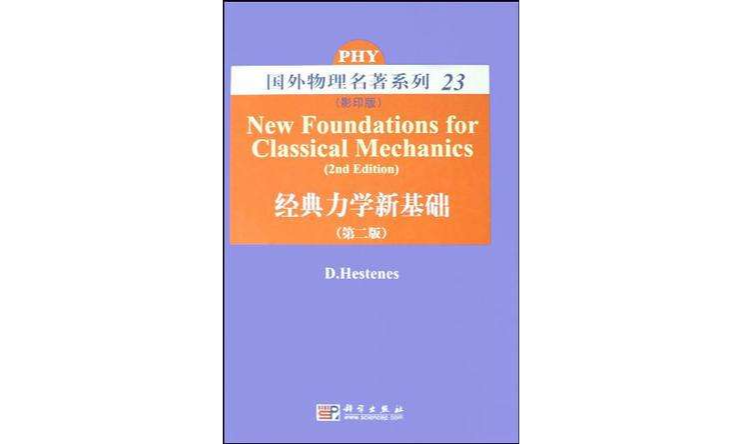《經典力學新基礎》是2009-1科學出版的圖書,作者是赫斯騰薩
基本介紹
- 作者:赫斯騰薩
- ISBN:9787030236272
- 頁數:703
- 定價:99.00元
- 出版社:科學
- 出版時間:2009-1
- 叢書: 國外物
內容介紹,作品目錄,
內容介紹
《經典力學新基礎(第2版)(影印版)》主要內容:This book provides an introduction to geometric algebra as an unified language for physics and mathematics. It containes extensive applications to classical mechanics in a textbook format suitable for courses at an intermediate level. The text is supported by more than 200 diagrams to help develop geometrical and physical intuition.Besides covering the standard material for a course on the mechanics of particles and rigid bodies, the book introduces new, coordinatefree methods for rotational dynamics and orbital mechanics,developing these subjects to a level well beyond that of other textbooks. These methods have been widely applied in recent years to biomechanics and robotics, to computer vision and geometric design, to orbital mechanics in governmental and industrial space programs, as well as to other branches of physics. The book applies them to the major perturbations in the solar system, including the planetary perturbations of Mercury's perihelion.
Geometric algebra integrates conventional vector algebra (along with its established notations) into a system with all the advantages of quaternions and spinors. Thus, it increases the power of the mathematical language of classical mechanics while bringing it closer to the language of quantum mechanics. This book systematically develops purely mathematical applications of geometric algebra useful in physics, including extensive applications to linear algebra and transformation groups. It contains sufficient material for a course on mathematical topics alone.
The second edition has been expanded by nearly a hundred pages on relativistic mechanics. The treatment is unique in its exclusive use of geometric algebra and in its detailed treatment of spacetime maps. Collisions, motion in uniform fields and relativistic precession. It conforms with Einstein's view that the Special Theory of Relativity is the culmination of developments in classical mechanics.
作品目錄
PrefaceChapter 1: Origins of Geometric Algebra1-1.Geometry as Physics1-2.Number and Magnitude1-3.Directed Numbers1-4.The Inner Product1-5.The Outer Product1-6.Synthesis and Simplification1-7.Axioms for Geometric AlgebraChapter 2: Developments in Geometric Algebra2-1.Basic Identities and Definitions2-2.The Algebra of a Euclidean Plane2-3.The Algebra of Euclidean 3-Space2-4.Directions, Projections and Angles2-5.The Exponential Function2-6.Analytic Geometry2-7.Functions of a Scalar Variable2-8.Directional Derivatives and Line IntegralsChapter 3: Mechanics of a Single Particle3-1.Newton's Program3-2.Constant Force3-3.Constant Force with Linear Drag3-4.Constant Force with Quadratic Drag3-5.Fluid Resistance3-6.Constant Magnetic Field3-7.Uniform Electric and Magnetic Fields3-8.Linear Binding Force3-9.Forced Oscillations3-10.Conservative Forces and ConstraintsChapter 4: Central Forces and Two-Particle Systems4-1.Angular Momentum4-2.Dynamics from Kinematics4-3.The Kepler Problem4-4.The Orbit in Time4-5.Conservative Central Forces4-6.Two-particle Systems4-7.Elastic Collisions4-8.Scattering Cross SectionsChapter 5: Operators and Transformations5-1.Linear Operators and Matrices5-2.Symmetric and Skewsymmetric Operators5-3.The Arithmetic of Reflections and Rotations5-4.Transformation Groups5-5.Rigid Motions and Frames of Reference5-6.Motion in Rotating SystemsChapter 6: Many-Particle Systems6-1.General Properties of Many-Particle Systems6-2.The Method of Lagrange6-3.Coupled Oscillations and Waves6-4.Theory of Small Oscillations6-5.The Newtonian Many Body ProblemChapter 7: Rigid Body Mechanics7-1.Rigid Body Modeling7-2.Rigid Body Structure7-3.The Symmetrical Top7-4.Integrable Cases of Rotational Motion7-5.Rolling Motion7-6.Impulsive MotionChapter 8: Celestial Mechanics8-1.Gravitational Forces, Fields and Torques8-2.Perturbations of Kepler Motion8-3.Perturbations in the Solar System8-4.Spinor Mechanics and Perturbation TheoryChapter 9: Relativistic Mechanics9-1.Spacetime and Its Representations9-2.Spacetime Maps and Measurements9-3.Relativistic Particle Dynamics9-4.Energy-Momentum Conservation9-5.Relativistic Rigid Body MechanicsAppendixA Spherical TrigonometryB Elliptic FunctionsC Units, Constants and DataHints and Solutions for Selected ExercisesReferencesIndex

